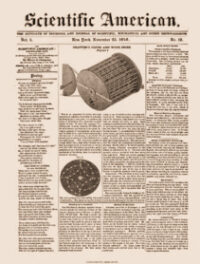The Scientific American
April 27
Reluctantly we recall the deplorable fact that civil war has actually broken out in our own country, where peace, happiness and financial prosperity have so long existed.
For some time past a feeling of animosity has prevailed in some of the remote Southern States against the people of the Northern States, who have been charged with imbibing hostile feelings toward the South, for the sentiments there existing on the subject of African slavery.
Soon after the election of Abraham Lincoln to the Presidential Chair, the citizens of South Carolina, Georgia, Florida, Alabama, Mississippi, Louisiana, and Texas formed themselves into a Southern Confederacy, and after meeting in convention, they adopted a constitution, and elected Hon. Jefferson Davis, formerly member of Congress from Mississippi, President of the Confederated States.
The first step of these Secessionists was the seizure of various forts, arsenals, custom houses, and other public buildings belonging to the Federal Government, and their occupation in opposition to the will of the Federal authorities. Fort Sumter, in the harbor of Charleston, South Carolina, and Fort Pickens, in the Gulf of Mexico, nearly opposite the city of Pensacola, Fla., the Secessionists were unable to obtain. Fort Sumter has been garrisoned with only about seventy men, under command of Major Anderson, for several months; the authorities of the Confederated Government objected to the garrison being reinforced.
The secessionist forces have been busily engaged during the last three months in erecting batteries around Fort Sumter, for the purpose of reducing it. About the time these batteries were completed and manned, the stores at Fort Sumter became nearly exhausted, and the privilege which had been conceded to Major Anderson to get supplies from the city was withdrawn. This step rendered it imperative in the Federal authorities to either surrender the fort or to resort to force to provision the garrison. The latter course was decided upon, and naval ships with stores and soldiers were hastily fitted out and sent to Major Anderson’s relief.
The authorities of the Southern Confederacy, learning that it was the determination of the Federal Government to provision the forts at all hazards, made a hasty demand upon Major Anderson to surrender; this he refused to do, and at twenty minutes past four o’clock on the morning of April 12, before the vessels containing reinforcements arrived, General Beauregard, commander of the Southern forces, commenced a cannonade on Fort Sumpter. The fire was returned, and continued until Saturday afternoon, when Major Anderson struck the United States flag and surrendered.
The details of the battle have been telegraphed to our daily papers, but they are so conflicting in their tenor as to be unworthy of record.
It is proper to state that the history of our national troubles, of which we have only given an abstract, is not intended to instruct or enlighten our own people, who are thoroughly conversant with all the facts, but for our patrons in foreign countries, who find it difficult to understand our political affairs.
A telegraphic dispatch just received from Washington states that the President of the United States has issued a proclamation calling out 75,000 militia, and that the first service required of them will be the retaking of the fortifications. An extra session of Congress is also called to meet on the fourth of July next.
